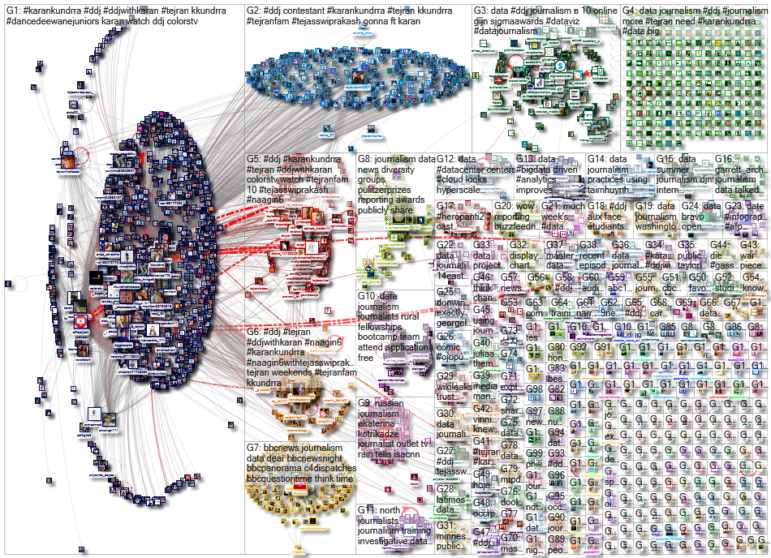
The Financial Times created a free-to-play game to test if readers can reduce global emissions enough to curb climate change. Image: Screenshot.
Could you save the earth from devastating climate change consequences if you were given the authority? The Financial Times’ climate game will test your ability to curb global warming. Our weekly NodeXL and human curation of the most popular data journalism stories on Twitter also highlights The Pudding’s analysis of who gets represented on banknotes around the world, ProPublica’s look at how America’s tax system favors the ultra-wealthy, Le Soir’s fact-checking of weather proverbs, and We Do Data’s sonification of French polling data.
Can You Save the Planet?
You have been appointed as a global official to protect future generations. Can you reduce a significant amount of greenhouse gases to curb the worst consequences of climate change? The Financial Times created an interactive game for readers to see if they could make wise policy decisions to help cut energy-related carbon dioxide emissions to net zero by 2050. The game is based on published scientific research and modelling by the International Energy Agency.
Immediately went to play https://t.co/T8KTtLm7x6 as soon as I saw the link. What a fascinating way to bring home the types of policy decisions that absolutely need to be made, and made now
— Michelle Bieger (@mfbieger) April 22, 2022
Whose Face is on Your Money?
Many countries around the world feature notable national figures on the face of their money. The Pudding analyzed the currency of 38 countries, involving 236 unique banknotes and 241 unique individuals, to see what trends or patterns would surface. No surprise here: they found that the majority of the individuals depicted are male (79%), and, on average, 29% of people in a country’s currency were known for being the first ones to do something. Curiously, there were more writers than politicians portrayed.
Have you ever wondered who gets to appear on a banknote?
It may surprise you to learn that, worldwide, writers are more likely to be noteworthy than politicians. https://t.co/bfopY434XM
— Lynne Everatt (@lynneeveratt) April 19, 2022
Taxing the Wealthiest Americans
ProPublica analyzed a trove of federal income tax data and found a system where the highest earners in the United States actually pay far lower tax rates than do the merely affluent. The rate of income tax that people pay does climb as incomes ascend, but when it hits the US$5 million annual income mark, average tax rates actually drop the more you earn. The report also examined the factors that contribute to this system of lower tax rates for the ultra-wealthy.
Bombshell report from @propublica reveals that the 25 richest Americans pay only 3.4% of their income in taxes from 2013 to 2018—compared with average wage earner who pays 24%. https://t.co/voSILc1zdQ
— Rebecca Nagle (@rebeccanagle) April 19, 2022
Who You Spend Time With
There are 525,600 minutes in a year. With whom do you spend most of that time? Statistician Nathan Yau analyzed data from the American Time Use Survey, examining people from age 15 to 80, and created an animated bar chart to visualize how Americans spend their time as they age. In our younger years, a lot of time is spent with parents and siblings. Co-workers, spouses, and children take up the bulk of middle age, while time with neighbors and acquaintances increases as one gets older.
🧐 @flowingdata's always mixing it up—love how the discussion is annotated w/ category colors from the chart!
📊 “Changing Who We Spend Time with as We Get Older” https://t.co/Q55rXlSZ8g #dataviz pic.twitter.com/a74TywzrRu— Mara Averick (@dataandme) April 22, 2022
Safe Travel During the Pandemic
As coronavirus rates starts to recede and borders of countries reopen to tourists, the Singapore daily The Straits Times looks at which destinations are considered ‘safe’ for travel. It determines this using two metrics of any particular country: COVID-19 vaccination and booster rates, and the strictness of health safety guidelines. The report includes a searchable table that shows the percentage of vaccinated population for more than 100 countries.
Catch flights, not #Covid-19: How do you pick a 'safe’ #holiday destination? Find out via @straits_times https://t.co/2TtLtDtq91
— StraitsTimesVisuals (@stvisuals1) April 19, 2022
Sidewalk Invasions
In recent years, terraces have colonized the public sidewalks of Madrid, the capital of Spain. El Periódico de España reports on how the uncontrolled proliferation of terraces has altered the urban landscape and affected mobility and accessibility, leaving a trail of neighborhood complaints. Those affected not only protest the noise but also the occupation of public space. The team mapped several of the most egregious abuses of public sidewalks in the city.
Invasión del espacio público, ruido y árboles quemados por estufas y focos: el resultado de la toma que han hecho las terrazas de un espacio que es de toda la ciudadanía para el disfrute de quienes pueden pagar por consumir ellas https://t.co/uDeHkiGJld
— Gemma Candela (@Gemma_Candela) April 19, 2022
Verifying the Truth of Weather Proverbs
June 8 is St. Médard’s Day, a day that commemorates the patron saint of weather and rain who lived about 1,500 years ago in France. The people of France have a saying: “Should St. Médard’s Day be wet, it will rain for forty yet…” But how true is this? The French-language Belgian daily newspaper Le Soir looked at 30 years of meteorological data to determine exactly how reliable common weather proverbs are.
Peut-on se fier aux vieux dictons météo?
« Le dicton honnête : en avril, ne te découvre pas d’un fil, en mai, prends un K-way. » 😂 https://t.co/JTNLJzFXPx— Maïté Abram (@maitea6) April 17, 2022
Russia’s Internet Ban
Roskomnadzor is the Russian agency responsible for monitoring, controlling, and censoring that country’s mass media. Novaya Gazeta Europe analyzed nearly 600,000 websites that have been officially blacklisted since 2004. The team identified five waves of mass website blocking, starting from the banning of religious and far-right literature to “undesirable” organizations, then removing compromising stories on officials, the purging of media and human rights organizations, and, finally, total censorship of “inaccurate” military mentions tied to Russia’s invasion of Ukraine. Also worth a look: The Washington Post has a piece on why Russia gave up on conquering Kyiv and turned its attention to the east of Ukraine.
Our first data research is on how Russian authorities destroyed Russian internet https://t.co/7tsr6pasMe
— Kirill Martynov (@kmartynov) April 21, 2022
QAnon
QAnon was a political conspiracy theory that evolved into a political movement, and is often referenced as a far-right extremist group. The Grid news site reviewed public records and reporting, social media posts, and campaign materials and events to identify and confirm at least 78 QAnon-aligned candidates running for office in 26 US states this year. The candidates are running for a wide variety of posts: governorships, secretaries of state, seats in the US Senate and House, and in state legislatures.
I’m a little late to it, but this investigative report is beyond alarming for the proper functioning of US democracy: QAnon candidates are on the ballot in 26 states h/t @JustinRood https://t.co/ITq7GdnpQL
— Carrie Cordero (@carriecordero) April 19, 2022
The Shape of COVID in South Africa
Data visualization collective Media Hack gathered detailed daily data on the coronavirus pandemic in South Africa over the past two years. The team has now visualized the data, revealing patterns in the waves of the disease, deaths in the provinces, excess fatalities, and number of vaccinations. Also interesting: The Wall Street Journal looks at company stocks that soared during the pandemic but are now declining.
The shape of a pandemic. We've been collecting Covid data for Africa for 2 years and this is an attempt at a slightly different visualisation of the data. Some of it is less didactic than previous work. https://t.co/ygZhGOJpBv #ddj #COVID #Datavisualization
— You can call me Al (@alastairotter) April 22, 2022
Bonus 11th Item: French Election
Inspired by a 2018 piece in Berliner Morgenpost, data visualization studio We Do Data presented French polling data for 12 election candidates using sonification in a tweet thread. Listen to the rise and fall of the popularity of each candidate on their own instrument: mandolin, organ, bass, marimba, piano, and more. Or listen to the whole cacophony of sounds for all 12 candidates here.
🗳🇫🇷🎶 Les sondages avaient-ils vu juste ? Et quelle était VRAIMENT leur petite musique sur 2 mois ?
Pour chaque candidat·e, première note : moyenne des sondages @NspPolls au 10 février, dernière note : résultats du 1er tour.
Mettez le son 🔊🔊🔊
Voici Macron, au piano…⬇️ pic.twitter.com/QhqgDOZeft
— WeDoData (@we_do_data) April 12, 2022
Thanks again to Marc Smith and Harald Meier of Connected Action for gathering the links and graphing them. The Top Ten #ddj list is curated weekly.
 Eunice Au is GIJN’s program manager. Previously, she was a Malaysia correspondent for Singapore’s The Straits Times, and a journalist at the New Straits Times. She has also written for The Sun, Malaysian Today, and Madam Chair.
Eunice Au is GIJN’s program manager. Previously, she was a Malaysia correspondent for Singapore’s The Straits Times, and a journalist at the New Straits Times. She has also written for The Sun, Malaysian Today, and Madam Chair.

